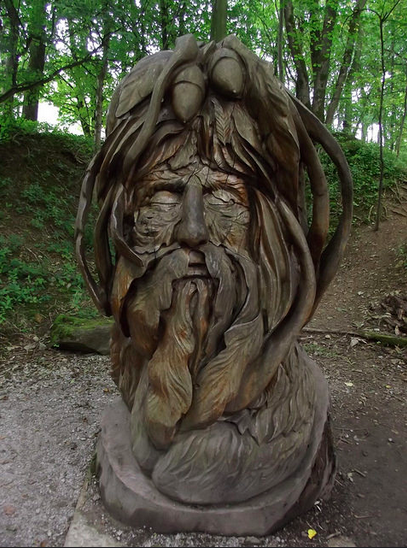After days of cold, grey rain, I needed to get out and walk.
Opening the gate in the tall deer fence, I stepped through into the soggy field with its newly sprouted carpet of vividly green English wheat. The sky shimmered blue overhead and a sheer, golden light illuminated the bare trees and the rolling Downs in the distance.
I headed south from our Sussex cottage, my rubber Wellies squashing noisily through the waterlogged grass and mud at the edge of the field. I had no clear intention of where I would walk but I wanted to avoid any roads and to keep only soft, wet earth underfoot, so I wandered footpaths that wove like bedraggled ribbons over wooded hill and dale.
Tromping along the muddy trail, enjoying both my exercise and being enfolded by trees and fields, I found myself reflecting on the Green Man, an ancient pagan archetype of masculine connection with Nature.
Far older than Christianity, the Green Man reemerged powerfully in the 12th century, and his image can be found carved into stone pillars in cathedrals throughout Europe. At the sacred site of Chartres, France, the Green Man can be found at least seventy-two times within the great cathedral, and over a hundred of his stone faces decorate Rosslyn Chapel in Scotland.
Depicted with his beard and hair growing or formed of leaves, vines and boughs, the Green Man is the steward of the forests and land. He embodies a silent, gentle wisdom through his respect of all living things.
Bearded and inherently masculine, he models a different kind of manhood and strength, one that is based on relationship, caring, and true husbandry or stewardship. He gives us a powerful metaphor and depiction of the Sacred Masculine.
◊♦◊
Living in the Old World, particularly when I wandered through whispering woods or less domesticated places, the gentle Green Man often entered my consciousness. On some subtle level, his energy is still present in the British Isles, somehow still existing in the wilder places and as a reemerging part of the regional folklore.
He is often called Jack of the Wood, or Jack of the Green, and is the basis for popular folklore characters, such as the Green Knight in the Arthurian legend of Sir Gawain and the Green Knight, and Robin Hood. In his classic form, the Green Man seems to be reemerging and growing in newfound popularity around the globe.
We do not have to be neo-pagans to appreciate this ancient, archetypal energy—an image of malehood entwined with nature and mystery. We don’t have to follow any religion at all. We do, however, need to possess a sense of soul.
Regrettably, ours is culture that lacks authentic rites of passage, soulful initiations and wise elders. In a materialistic society that doesn’t really value or support the soul, many of us are searching for some sense of deeper meaning in our lives. Alongside that, reclaiming an affirming archetype of a Sacred Masculine as counterpart to the Divine Feminine seems timely and overdue—and essential for evolving our notions of masculinity.
In that search, we look to discover an affirming embodiment of the masculine that is connected to something larger. Men need role models who teach us that we each have something essential to bring to our community and the world, mentors who understand that everything is related to everything else, and that the heart is a true compass.
Enter the Green Man, a strong and compassionate masculine who respects the hidden laws of nature and interconnected relationship. In a modern incarnation, he stands for environmental awareness and action; he symbolizes cooperation with nature rather than dominion over it for resources, wealth, and power. In a sense, he is the original eco-warrior.
In the search to discover a role model or affirming embodiment of the masculine, if we look to classic myths to archetypes we could find multiple metaphors that represent the Sacred Masculine, yet somehow the Green Man seems uniquely relevant, approachable and timely.
◊♦◊
A few years ago, I returned from Europe to live in the States. While I cannot say that on my walks in the wilds and semi-wilds of coastal California I sense the Green Man as I did in England, I seem to have taken on that archetypal energy in a different manner. He is in me.
He’s reflected in the choices I make with my food—where was this raised, how was it produced, how far has it traveled to reach me? When I shop at the weekly farmer’s market and put my dollars directly into the hands of those who tended the earth and grew the ingredients for my supper, the Green Man is there.
He is present in the way I wash my dishes in a plastic tub in the sink and then pour the water onto the plants on my deck and garden (yes, it’s an eco-friendly dish soap). He is my awareness of my carbon footprint, driving less and staying local, and having a fuel-efficient automobile.
The Green Man is present in each of us when we endeavor to buy and use less, when we recycle and reuse as much as possible. Nature never wastes anything. We embody the archetype when we practice stewardship and remember that everything is interconnected and in relationship.
The bearded man of the wood also represents and personifies something essential that we have lost: the wild soul.
In a modern urban culture, the vast majority of us are very disconnected from nature. We are thoroughly domesticated. Wedded to technology and distractions, any sense of wildness has been effectively banished from our air-conditioned lives. The result is that we are severed from a deeper, authentic sense of ourselves—from our innate power and wildness. (To be clear, I mean wildness as in nature and soul, not destructive.)
I’m talking about something more than merely Nature Deficit Disorder. Essential as our connection with nature is, nearly every one of us could benefit from some broader re-wilding: a loosening of our suits, neckties and familiar restrictions. We need a reconnection with something more authentic, more feral than fashionable.
The wild soul is the authentic, creative, timeless core within us—the part that not only connects to and appreciates nature, but also is nature.
◊♦◊
I cannot count the hours I spent roaming the green landscape of England in my years of living there. Beneath a heavy grey sky, crossing tidy fields bordered with hedgerows, or wandering through shady dells and whispering woods, I met sly red foxes, spotted deer, bounding rabbits, and all manner of wild things.
With my senses open and ajar, I felt not only a sense of my own wild soul—an expansion in my heart, a quiet humming of visceral power in my body—but also a kinship with the living earth. We are not separate, after all.
When I walk in wild places—anywhere, really—and see the world not just an assortment of separate objects, or even an ‘ecosystem’, but as an interconnected, creative relationship, that is the Green Man and the Sacred Masculine embodied in me.
It is the Green Man who daily feeds the scrub jays, dark-eyed juncos, hummingbirds, and crows that I share this patch of earth with. And he’s there when I sit outside on the front porch in the evenings, observing the light fade amid the gnarled oaks and windswept Monterey cypresses, or watching the fog roll in to blanket the town.
In his quiet, affirming way, the Green Man teaches that the wild soul and the Sacred Masculine are interwoven, and that we are all interconnected—human, non-human, and planetary.
Somewhere in your soul, there’s a wild man of the wood waiting to be discovered.
~
Author: L. R. Heartsong
Editor: Katarina Tavčar
Photo: Elliot Brown/Flickr, Igor Trepeshchenok/Barn Images







Read 3 comments and reply